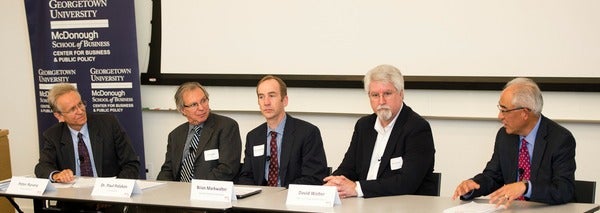Policy Event Summary, Video: The Innovation & Engineering Dynamics of the Digital Economy: Economic Transformation & Expansion Enabled by 5G
Posted in Announcements News

Full policy event summary, including program information and participant biographies.
On Oct. 14, the Georgetown Center for Business and Public Policy’s Project on the Evolution of Innovation and Regulation, together with the Wireless Technology Association, convened more than 80 attendees and 20 speakers from research institutions, think tanks, Capitol Hill, the White House, universities, embassies, and the U.S. mobile industry to discuss the innovation and engineering dynamics of the digital economy. The technical presentations and policy discussions focused on the possibilities that 5G mobile broadband will create for the U.S. economy, U.S. consumers, and the country’s ability to remain a global leader in spectrum innovation. Cisco Fellow Paul Polakos delivered a keynote address focused on information-centric networking and the evolution of the Internet, and Federal Trade Commission (FTC) Commissioner Maureen Ohlhausen concentrated on the potential of the Industrial Internet of Things (IoT) to add a layer of connectivity between objects that will kickstart innovations in healthcare, transportation, and other sectors of the U.S. economy. The top takeaways from the day-long event include:
- The killer app for 5G will be the impact it will have on the U.S. economy as long as the development of the underlying network architecture and radio access technologies are not hamstrung by discordant spectrum policy in Washington.
- 5G will be a catalyst for information-centric networking which has the potential to create a new internet architecture in which transport, mobility, security, and content are integrated in one network.
- 5G will support diverging requirements though multi-radio access technology solutions and will enable networks to deliver a multitude of different services to an array of devices.
- One of the key benefits of 5G will be the ability to deliver ultra-fast mobile broadband connectivity at a price point that will be accessible to a majority of U.S. consumers and businesses of all sizes.
- 5G will increase use cases for wireless broadband, ranging from IoT applications, to rapid-response, control-oriented systems, to ultra-broadband.
- Many of the more transformative 5G use cases will benefit from traffic prioritization.
- Global spectrum harmonization is critical to the success of 5G.
- Many countries around the globe are devoting significant resources to making 5G their “moon landing,” putting even more pressure on the U.S. government to act quickly to identify spectrum bands for global harmonization and to make more spectrum available for wireless broadband.
